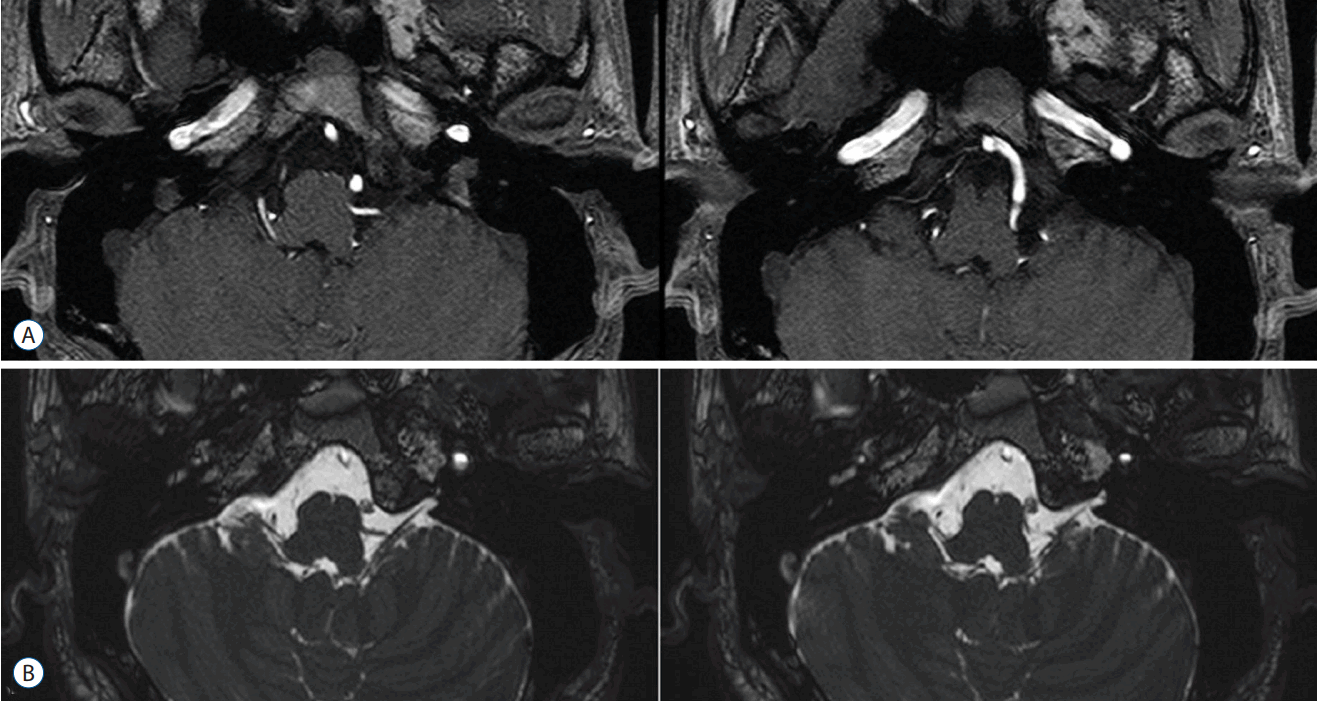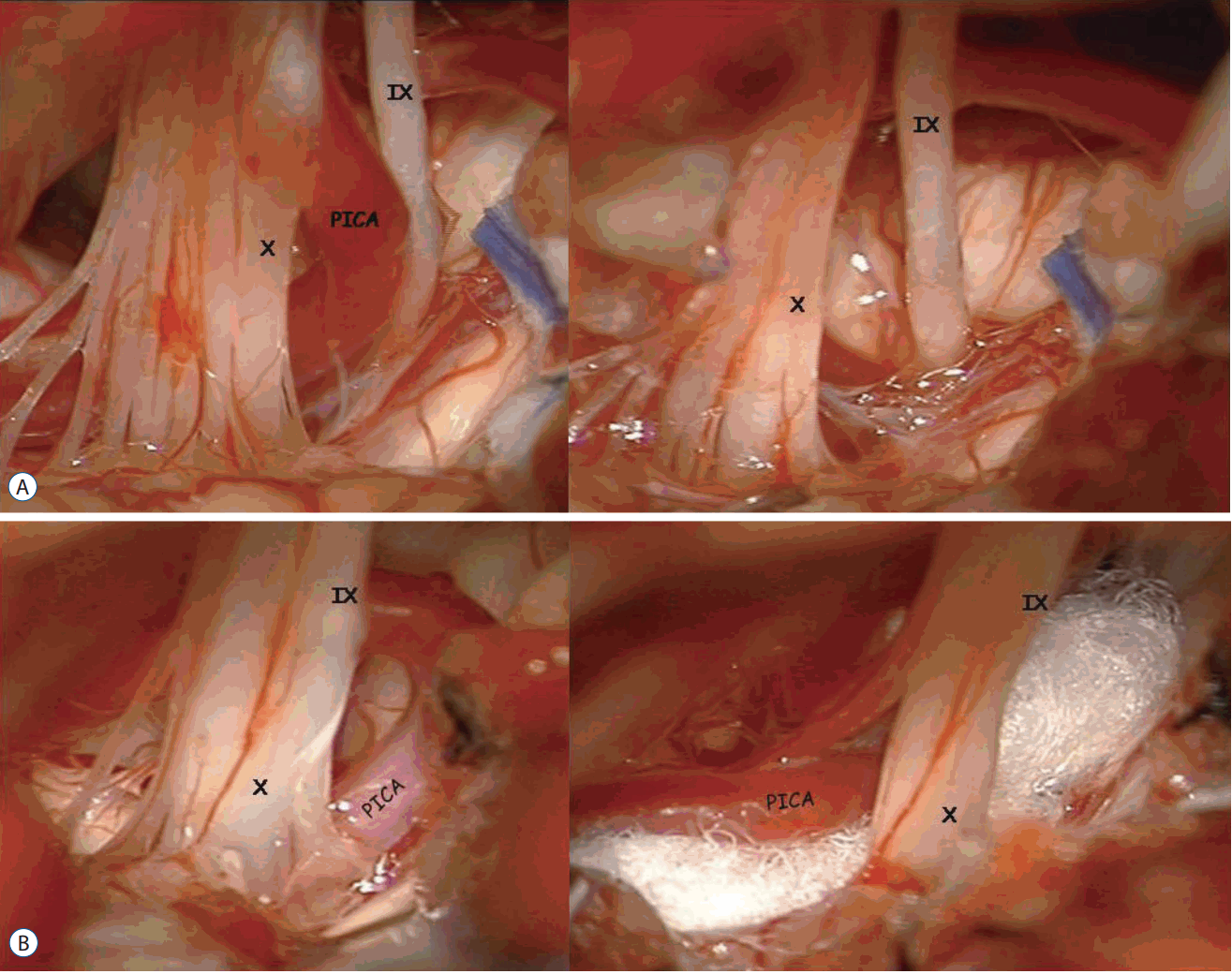1. Baechli H, Gratzl O. Microvascular decompression in trigeminal neuralgia with no vascular compression. Eur Surg Res. 39:51–57. 2007.

2. Barbash GI, Keren G, Korczyn AD, Sharpless NS, Chayen M, Copperman Y, et al. Mechanisms of syncope in glossopharyngeal neuralgia. Electroencephalogr Clin Neurophysiol. 63:231–235. 1986.

3. Chen J, Lee S, Lui T, Yeh Y, Chen T, Tzaan W. Teflon granuloma after microvascular decompression for trigeminal neuralgia. Surg Neurol. 53:281–287. 2000.

4. Choi MS, Kim YI, Ahn YH. Lipoma causing glossopharyngeal neuralgia: a case report and review of literature. J Korean Neurosurg Soc. 56:149–151. 2014.

5. Dandy WE. Glossopharyngeal neuralgia (tic douloureux): Its diagnosis and treatment. Arch Surg. 15:198–214. 1927.
6. De Ridder D, Møller A, Verlooy J, Cornelissen M, De Ridder L. Is the root entry/exit zone important in microvascular compression syndromes? Neurosurgery. 51:427–434. discussion 433–434. 2002.

7. Ferroli P, Fioravanti A, Schiariti M, Tringali G, Franzini A, Calbucci F, et al. Microvascular decompression for glossopharyngeal neuralgia: a long-term retrospectic review of the Milan-Bologna experience in 31 consecutive cases. Acta Neurochir (Wien). 151:1245–1250. 2009.

8. Gadient PM, Smith JH. The neuralgias: diagnosis and management. Curr Neurol Neurosci Rep. 14:459. 2014.

9. Headache Classification Committee of the International Headache Society (IHS). The international classification of headache disorders, 3rd edition (beta version). Cephalalgia. 33:629–808. 2013.
10. Horowitz M, Horowitz M, Ochs M, Carrau R, Kassam A. Trigeminal neuralgia and glossopharyngeal neuralgia: two orofacial pain syndromes encountered by dentists. J Am Dent Assoc. 135:1427–1433. quiz 1468. 2004.
11. Jannetta PJ. Neurovascular compression in cranial nerve and systemic disease. Ann Surg. 192:518–525. 1980.

12. Jannetta PJ, Abbasy M, Maroon JC, Ramos FM, Albin MS. Etiology and definitive microsurgical treatment of hemifacial spasm: Operative techniques and results in 47 patients. J Neurosurg. 47:321–328. 1977.
13. Jannetta PJ, Segal R, Wolfson SK Jr. Neurogenic hypertension: etiology and surgical treatment. I Observations in 53 patients. Ann Surg. 201:391–398. 1985.
14. Kabatas S, Karasu A, Civelek E, Sabanci AP, Hepgul KT, Teng YD. Microvascular decompression as a surgical management for trigeminal neuralgia: long-term follow-up and review of the literature. Neurosurg Rev. 32:87–93. discussion 93–94. 2009.

15. Kandan SR, Khan S, Jeyaretna DS, Lhatoo S, Patel NK, Coakham HB. Neuralgia of the glossopharyngeal and vagal nerves: long-term outcome following surgical treatment and literature review. Br J Neurosurg. 24:441–446. 2010.

16. Kano H, Urgosik D, Liscak R, Pollock BE, Cohen-Inbar O, Sheehan JP, et al. Stereotactic radiosurgery for idiopathic glossopharyngeal neuralgia: an international multicenter study. J Neurosurg. 125(Suppl 1):147–153. 2016.

17. Katusic S, Williams DB, Beard CM, Bergstralh E, Kurland LT. Incidence and clinical features of glossopharyngeal neuralgia, rochester, minnesota, 1945–1984. Neuroepidemiology. 10:266–275. 1991.

18. Kawashima M, Matsushima T, Inoue T, Mineta T, Masuoka J, Hirakawa N. Microvascular decompression for glossopharyngeal neuralgia through the transcondylar fossa (supracondylar transjugular tubercle) approach. Neurosurgery. 66(6 Suppl Operative):275–280. discussion 280. 2010.

19. Kondo A. Follow-up results of using microvascular decompression for treatment of glossopharyngeal neuralgia. J Neurosurg. 88:221–225. 1998.

20. Laha RK, Jannetta PJ. Glossopharyngeal neuralgia. J Neurosurg. 47:316–320. 1977.

21. Lee SH, Park JS, Ahn YH. Bioglue-coated teflon sling technique in microvascular decompression for hemifacial spasm involving the vertebral artery. J Korean Neurosurg Soc. 59:505–511. 2016.

22. Li D, Wang H, Fan Z, Fan Z. Complications in retrosigmoid cranial nerve surgery. Acta Otolaryngol. 130:247–252. 2010.

23. Matsushima T, Yamaguchi T, Inoue TK, Matsukado K, Fukui M. Recurrent trigeminal neuralgia after microvascular decompression using an interposing technique. Teflon felt adhesion and the sling retraction technique. Acta Neurochirur (Wien). 142:557–561. 2000.

24. Meaney JF, Eldridge PR, Dunn LT, Nixon TE, Whitehouse GH, Miles JB. Demonstration of neurovascular compression in trigeminal neuralgia with magnetic resonance imaging. Comparison with surgical findings in 52 consecutive operative cases. J Neurosurg. 83:799–805. 1995.

25. Paleologos TS, Wadley JP, Kitchen ND, Thomas DG. Clinical utility and cost-effectiveness of interactive image-guided craniotomy: clinical comparison between conventional and image-guided meningioma surgery. Neurosurgery. 47:40–47. discussion 47–48. 2000.

26. Patel A, Kassam A, Horowitz M, Chang YF. Microvascular decompression in the management of glossopharyngeal neuralgia: analysis of 217 cases. Neurosurgery. 50:705–710. discussion 710–711. 2002.

27. Reddy K, Hobson D, Gomori A, Sutherland GR. Painless glossopharyngeal “neuralgia” with syncope: a case report and literature review. Neurosurgery. 21:916–919. 1987.

28. Resnick DK, Jannetta PJ, Bissonnette D, Jho HD, Lanzino G. Microvascular decompression for glossopharyngeal neuralgia. Neurosurgery. 36:64–68. discussion 68–69. 1995.

29. Riley HA, German WJ, Wortis H, Herbert C, Zahn D, Eichna L. Glossopharyngeal neuralgia initiating or associated with cardiac arrest. Trans Am Neurol Assoc. 68:28–29. 1942.
30. Rogers CL, Shetter AG, Fiedler JA, Smith KA, Han PP, Speiser BL. Gamma knife radiosurgery for trigeminal neuralgia: the initial experience of the Barrow Neurological Institute. Int J Radiat Oncol Biol Phys. 47:1013–1019. 2000.

31. Rushton JG, Stevens JC, Miller RH. Glossopharyngeal (vagoglossopharyngeal) neuralgia a study of 217 cases. Arch Neurol. 38:201–205. 1981.

32. Sampson JH, Grossi PM, Asaoka K, Fukushima T. Microvascular decompression for glossopharyngeal neuralgia: long-term effectiveness and complication avoidance. Neurosurgery. 54:884–889. discussion 889–890. 2004.

33. St John JN. Glossopharyngeal neuralgia associated with syncope and seizures. Neurosurgery. 10:380–383. 1982.

34. Taha JM, Tew JM Jr. Long-term results of surgical treatment of idiopathic neuralgias of the glossopharyngeal and vagal nerves. Neurosurgery. 36:926–930. discussion 930–931. 1995.

35. Taha JM, Tew JM Jr, Keith RW, Payner TD. Intraoperative monitoring of the vagus nerve during intracranial glossopharyngeal and upper vagal rhizotomy: technical note. Neurosurgery. 35:775–777. 1994.

36. Tsuboi M, Suzuki K, Nagao S, Nishimoto A. Glossopharyngeal neuralgia with cardiac syncope. A case successfully treated by microvascular decompression. Surg Neurol. 24:279–283. 1985.

37. Varrasi C, Strigaro G, Prandi P, Comi C, Mula M, Monaco F, et al. Complex pattern of convulsive syncope in glossopharyngeal neuralgia: video/EEG report and short review. Epilepsy Behav. 20:407–409. 2011.

38. Xiong NX, Zhao HY, Zhang FC, Liu RE. Vagoglossopharyngeal neuralgia treated by microvascular decompression and glossopharyngeal rhizotomy: clinical results of 21 cases. Stereotact Funct Neurosurg. 90:45–50. 2012.

39. Yomo S, Arkha Y, Donnet A, Régis J. Gamma knife surgery for glossopharyngeal neuralgia: report of 2 cases. J Neurosurg. 110:559–563. 2009.
40. Zhao H, Zhang X, Zhu J, Tang YD, Li ST. Microvascular decompression for glossopharyngeal neuralgia: long-term follow up. World Neurosurg. 102:151–156. 2017.







 PDF
PDF Citation
Citation Print
Print


 XML Download
XML Download